In previous blogs we have dealt with Detective Malcolm Thomas and his particular fetish for abusing the law around search warrants. This blog deals again with that exact subject. On the 1st November 1988 Detective Malcolm Thomas stopped a truck leaving the car park of the brothers restaurant.
Thomas was accompanied by a constables Reedy and Waugh. Thomas on approach flashed a piece of paper claiming that it was a search warrant and advised the brothers that he intended searching the vehicle. Despite the speed with which Thomas had flashed the document one of the brothers noticed that the form did not appear to have any signature.
Not having had been given the opportunity to read the document one brother demanded to be given the purported warrant so as to read it thoroughly, in the process attempting to grab the papers, which was of course their legal entitlement.
Thomas refused that reasonable request and threatened the brothers with arrest; he then searched the vehicle taking photographs whilst the brothers left and went to the police station to make a compliant.
Bare in mind that the brothers already knew why Thomas had been obtaining warrants and then photographing the equipment. He had been contacting creditors and then sending them photographs to incite repossessions and solicit complaints of theft.
The brothers advised the officers at the station, taking their, compliant that Thomas had refused to show them the purported search warrant used to search their vehicle and that they believed it to be a sham.
Following that complaint the police, including Detective Senior Sergeant Steve Shortland, typically, conspired to cover for Thomas and the fact that he didn’t have a warrant, he did not even have time to complete the copy he had in his hand when searching the vehicle.
The brothers then made a freedom of information request for the entire file. Given the police behaviour to date they knew that the warrant was not likely to have been executed by the courts at the time of the search and hoped to obtain the details of who had authorized it after the fact – that to would have amounted to serious corruption on the part of a judge or registrar, had they known that the search had already been conducted.
Knowing that the warrant had been executed at 11.15 am, it should have been a simple matter of speaking to the judge or the other court officials who may have authorised it; so as to ascertain the time the document had been signed.
When the file arrived the signature on the warrant had been redacted. The matter was left with senior police unreasonably refusing to provide further detail.
Twenty two years later the complete file was released with a further FOI request. With it, three very interesting photocopied documents. The file contained the unsigned copy of the warrant that Thomas had flashed at the brothers on the morning of the 1st November 1988.
It also contained a copy of the version Thomas had executed. ( you will soon be able to view images of the warrants below with an analysis of the descrepencies); you’ll notice less than subtle differences. The copy signed by the deputy registrar had obviously been altered or added to prior to her signing.
This in itself evidences that the brothers had indeed been right. Thomas had been bluffing; there was no warrant; it had yet to be authorised by the court. At the time of the search it was nothing more than an application for a warrant. There was however more damning evidence in the file; Detective Thomas’s own Job sheet detailing events and his own detailed chronology.
Thomas claims, rightly, that he searched the truck at 11.15am; but then the story starts to get just a little surreal. Thomas goes on to claim that he had noticed the vehicle reversed into the loading dock at 11.00 am, just fifteen minutes earlier. He then claims, in the same job sheet, that he first acted when he saw the brothers loading goods into the vehicle. The detective then apparently took the time to speak with Detective Sergeant Steve Shortland first before seeking his permission to obtain a search warrant.
He then apparently sits at his type writer and produces the application for a search warrant complete with an affidavit in support (which it seems has never existed); drives to the court house; has the warrant formally issued; then back to where the brothers were; the vehicle still located in the car park of the premises; Thomas then walks over and performs the search; all in just fifteen short minute’s.
In his job sheet he advises that he had instructed an I car to stop the brothers vehicle, this too strangely never occurred. Thomas and Reedy were both on foot.
There are a number of other problems for Detective Thomas; in the detail of the warrant Thomas claims theft as the crime he is investigating.
Thomas had conspired with Hi-lite inciting them to falsely accuse the brothers of the theft of chattels Hi-Lite had absolutely no entitlement too in the first place. Thomas also lists RSL, allegeing theft of their chattels. Unfortunately for Thomas RSL had absolutely no right to be acting in the property as at the 1st November 1988. We therefore very much doubt that a genuine complaint had even been recieved by Thomas prior to the unlawful search.
Pretty incredible really, not because we seriously believe Thomas to be superhuman or in fact that it had even really occurred! No, more because we now know without any doubt whatsoever that Senior Sergeant Steve Shortland and Thomas’s other superiors knew that his account, the job sheet he had produced was a complete and utter fabrication – the warrant did not exist when the search was conducted – it couldn’t have – it was was impossible for Thomas to have undertaken what he’d claimed to have done in less than fifteen minutes
The first point is that Thomas always, listening to the taped police interviews, humbly makes a point of admitting his weakness in writing and typing, at times taking up to five minute to produce a single sentence.
Then there is the impossible proposition that he undertook getting to and from the court house in what appears to have been, by our calculations, a little over three minutes. The court didn’t have a drive through! The brothers were also naturally keeping an eye on the police station which was located directly opposite; Thomas never left the police compound until such time as he walked over from the station and approached the brothers on foot at 11.15am
Of course then you have the brothers claim that Thomas had refused to show them the warrant and more importantly the signature. We know he refused, that’s documented, we also know that the existence of a signature was challenged, that fact had been central to the formal compliant.
Why would Thomas have refused, had all been in order? No, Thomas’s refusal to show the warrant when demanded to do so was because it was indeed unsigned and thus unauthorized. In short that means Detective Thomas had unlawfully detained, searched and threatened arrest!
Now, to top that little lot off we have a copy of the document Thomas had waived at the brothers, the unsigned version and also an court executed version, why would there be two distinctly different warrants on file? Well perhaps by the time Thomas eventually got to the court to have it authorized he had needed to make a few alterations at the assistant registrars insistence and then neglected to remove or destroy the first, the copy he’d refused to show the brothers because it hadn’t been signed.
Normally police are required when requested to give you an unsigned copy of the warrant but you have the right to sight the original. The unsigned copy should however be materially the same document in every other aspect. The unsigned document on the police file is not a true copy. Also of interest is the fact that there is no affidavit in support.
Now to answer the question: “When is a search warrant not a search warrant?” The answer of course: when the courts have not issued one! Thomas had again lied, in fact, he had just illegally searched a vehicle. Why? Because he and his mates had plans to steal more chattels and did not want the gear going missing before they could get their hands on it.
Warrants, Job Sheets and analysis
As stated above there were three copies of the same warrant allegedly issued on the 1st November 1988. Thomas alleges at some time within 11.00am and 11.15 am.
The brothers held that Thomas did not have a legitimate warrant, that the copy he had was unsigned. They have said, backed up by the written record that Thomas was taking photographs of the items on the truck. Including a large illuminated canopy.
According to to the brothers recollection Thomas had stated that he was looking for equipment belonging to Hi-Lite Industries, CFC and Registered Securities. The Brothers knew at the time that Thomas had absolutely no right to be dealing in any Registered Securities matters.
RSL had not taken possession of the properties, there was an application before the high court to injunct RSL and their property law act notices. Most important, however, was the fact that Thomas had not yet received a theft complaint from RSL, he couldn’t have the properties and equipment, as at the 1st November 1988, was not RSL’s to deal with.
Thomas in fact makes little mention of RSL in his job sheet other than noting a chattel security that he had somehow inexplicably managed to obtain. We know now that Thomas had been given this document by his old Mate ex-cop Steve Dimery, Dimery had been unlawfully dealing in the property and working for RSL since late August – That much was confirmed by Kieth Mitchellmore, Hi-lite Industries accounts Clerk.
Whilst on the Subject of Kieth Mitchellmore, Hi-Lite and Thomas, Thomas had incited and actively assisted in Hi-lites many attempts to steal the equipment. Thomas had also solicited their false complaint of theft. A week prior to the truck being searched the brothers had in fact been successful in defending the spurious civil claim that hi-lite had brought in the high court. Thomas was obviously also completely aware that the Hi-Lite theft complaints were his own invention.
Ultimately the brothers were successful in obtaining judgement against Hi-Lite Industries for $26’000.000. Because of Detective Thomas’s criminal actions the brothers were unable to claw back the money Hi-Lite had been over paid , obtained with fraudulent invoicing; Hi-Lite was declared insolvent.
On the left is a copy of the bogus warrant we believe Thomas used to facilitate the unlawful search The document he had flashed at and subsequently refused to allow the brothers to sight properly.
At the top of this version Thomas has typed:
“a 1976 Toyota truck registration number HQ3151, owned, operated or used by the XXXXXXXX Gisborne”
Note the positioning of the words, as in where the are located in each line of typed text, this is important.The reason why will become self evident once you have seen Warrant version II.
The second body of text Thomas has typed:
“Electronic gear, electrical light fittings and property owned by CFC Finance, Hilite Industries and RSL”
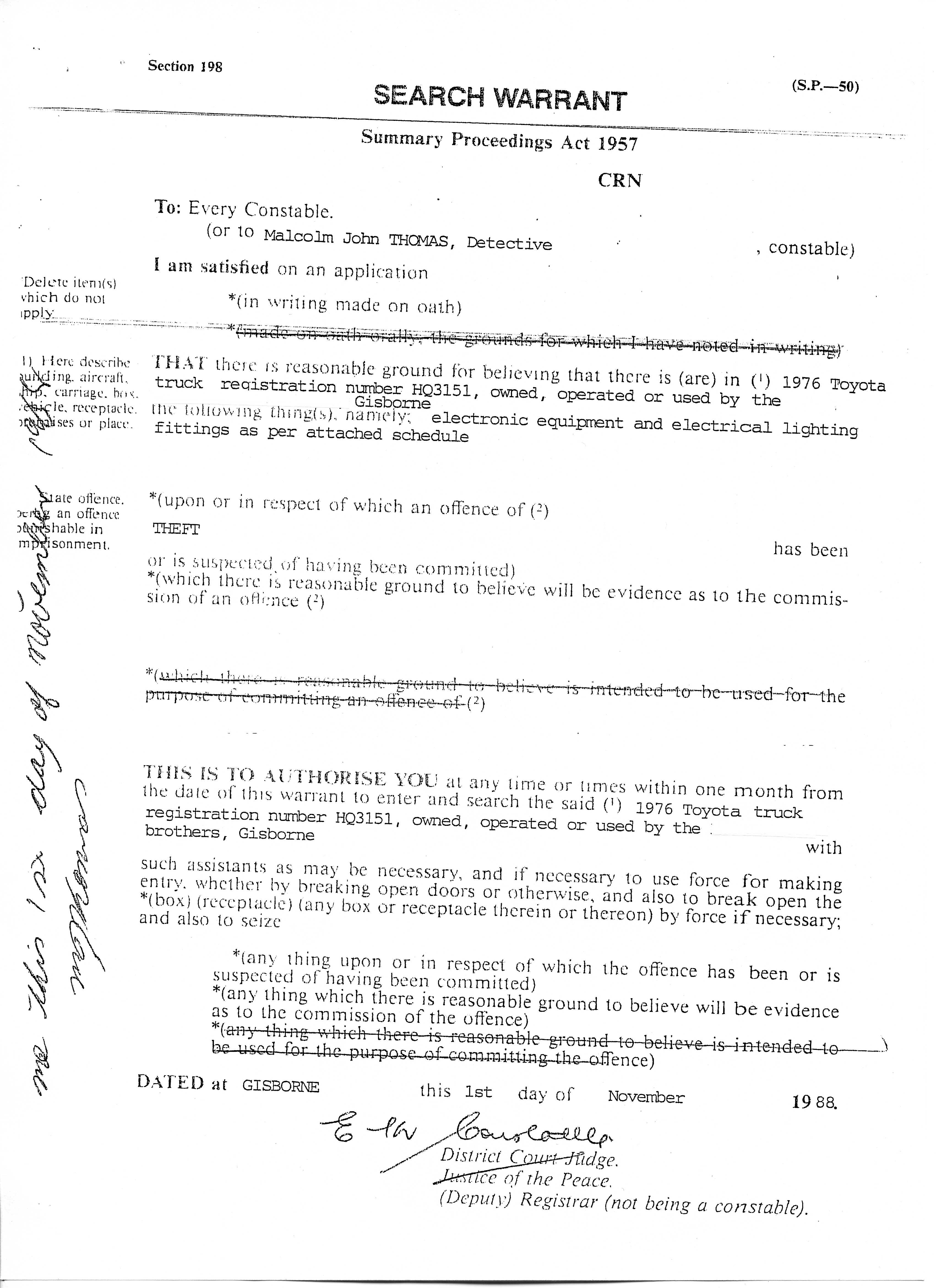
Warrant version II, the vastly different version Thomas had signed after the search later the same day
This too is important to note and again it will be apparent once Version II has been seen. The unsigned warrant appears to include items that Detective Thomas had verbally advised the brothers he was looking for. We now go to version II of the Warrant. when casually parusing this document it is quite different from the first – The one Thomas had bluffed the brothers with by not allowing them to inspect it and then threatening arrest.
Version II of the warrant is the copy that Thomas after the search took to the court and had authorised, it clearly has a signature at the bottom, purporting to be that of a registrar or deputy registrar.
At the top of this warrant the typed details of the vehicle and owners are arranged on different lines to that of version I.
This version also has hand drawn lines through various clauses in the standardized department of Justice/police search warrant form.
The next block of text, the description of what Thomas is searching for is also different, in fact a radical departure from the first Warrant:
“Electronic equipment and electrical lighting fittings as per attached schedule”
The affidavit in support, however, is nowhere to be seen in the police file – we believe because he never produced one, after all, probably no need, a Judge wasn’t deciding this warrant, just one of the dodgy court officials who were by now, used to doing favours for their corrupt mates.
In late November 1988 the brothers wrote to Commander Derecourt requesting a complete copy of the file Derecourt responded in January 1989. In that FOI release, purporting to be the entire file Derecourt had made sure that all names were redacted, obviously following Shortland’s advice, using the hackneyed excuse that police needed to protect people from the extremely violent and dangerous brothers – the truth of course was that Shortland needed to conceal names so that the individuals could not be identified and questioned.
With the release came a copy of the warrant, with the identifying name of the court official redacted. The brothers at the time deduced rightly that the warrant had not been approved by Judge Ian Thomas, the police would not have bothered to redact his name; there was absolutely no chance for the brothers to have questioned him.
The brothers also knew that a Judge following process would have required an affidavit in support of any application which as previously noted has always been strangely absent from the files police have released.
Of importance though is that the alternate version of the warrant was not released in January 1989, no doubt at the time it was still in the control of Detective Malcolm Thomas. The fact that it has even seen the light of day was doubtless of an oversight by Thomas in neglecting to destroy it immediately. Thomas was not efficient with paper work his office was always a mess.
The version released in January 1988 is identical to the document released in 2009, the one that contains the signature of the registrar.
Did Thomas have the time or in fact need to create to two versions before heading of to the court house? Of course not, why would he, if the alternate document had been a error in typing he would have immediately binned the mistake.
Thomas undoubtedly used the first unsigned version to unlawfully detain and search the brothers truck, after all Constable Reedy claimed he had seen the Warrant in Thomas’s hand, you’ll note that the words “SEARCH WARRANT” are quite prominent, the detail less so.
Then following the unlawful search Thomas had second thoughts, knowing that RSL had not yet made a complaint of theft, he typed up the the second version which he then had authorised later that same day by an obliging registrar, who was none the wiser.
Thomas was shrewd but he was by no means an intelligent man; in fact having seen his endeavours the man appears to have been as thick as pig shit. Thomas had previously made and continued to make similar mistakes with this, his incredibly shonky paperwork.
Read the Job sheets below, Constable Reedy would only state that he saw the warrant in Thomas’s hand; remember the aforesaid prominence of the heading “SEARCH WARRANT”. Interestingly Reedy at that point declines to acknowledge that Thomas had in fact shown the purported warrant to the brothers, why would he have, because he knew Thomas hadn’t.
Related articles
- Phil Kitchin – Judge prefers local mans story (laudafinem.wordpress.com)
- Detective Malcolm John Thomas – “The Planter” – Where is he now? (laudafinem.wordpress.com)
- Jenni McManus the nexus of media malfeaseance (laudafinem.wordpress.com)
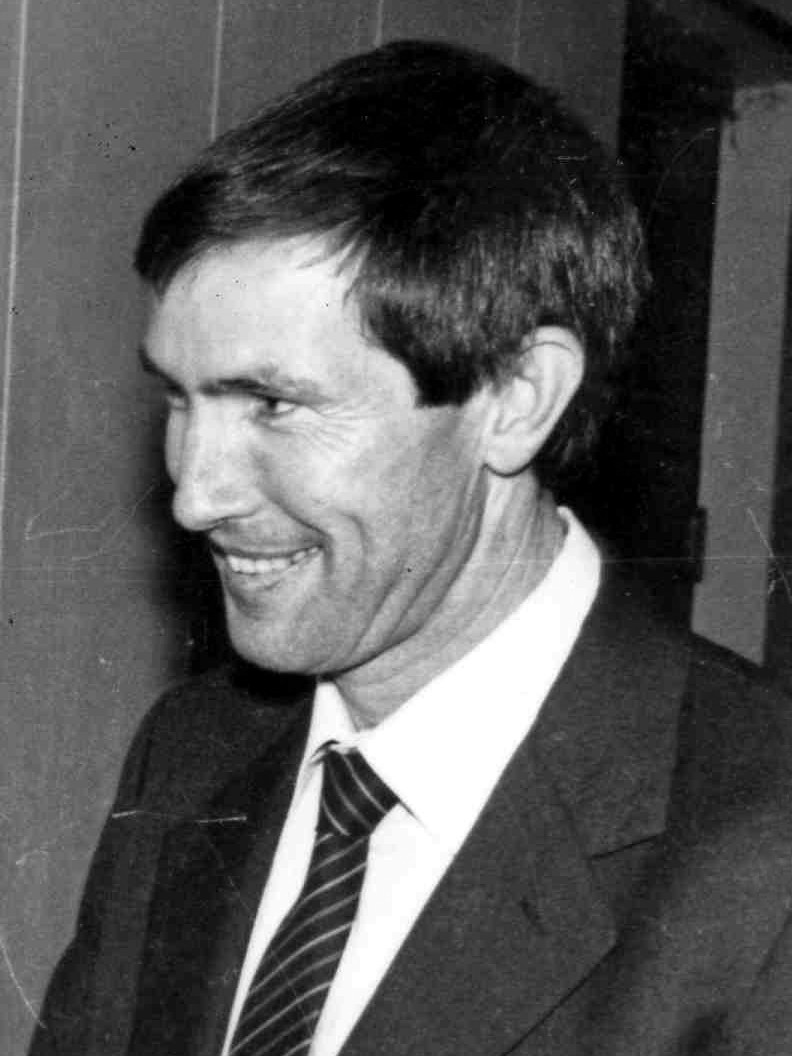
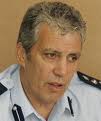
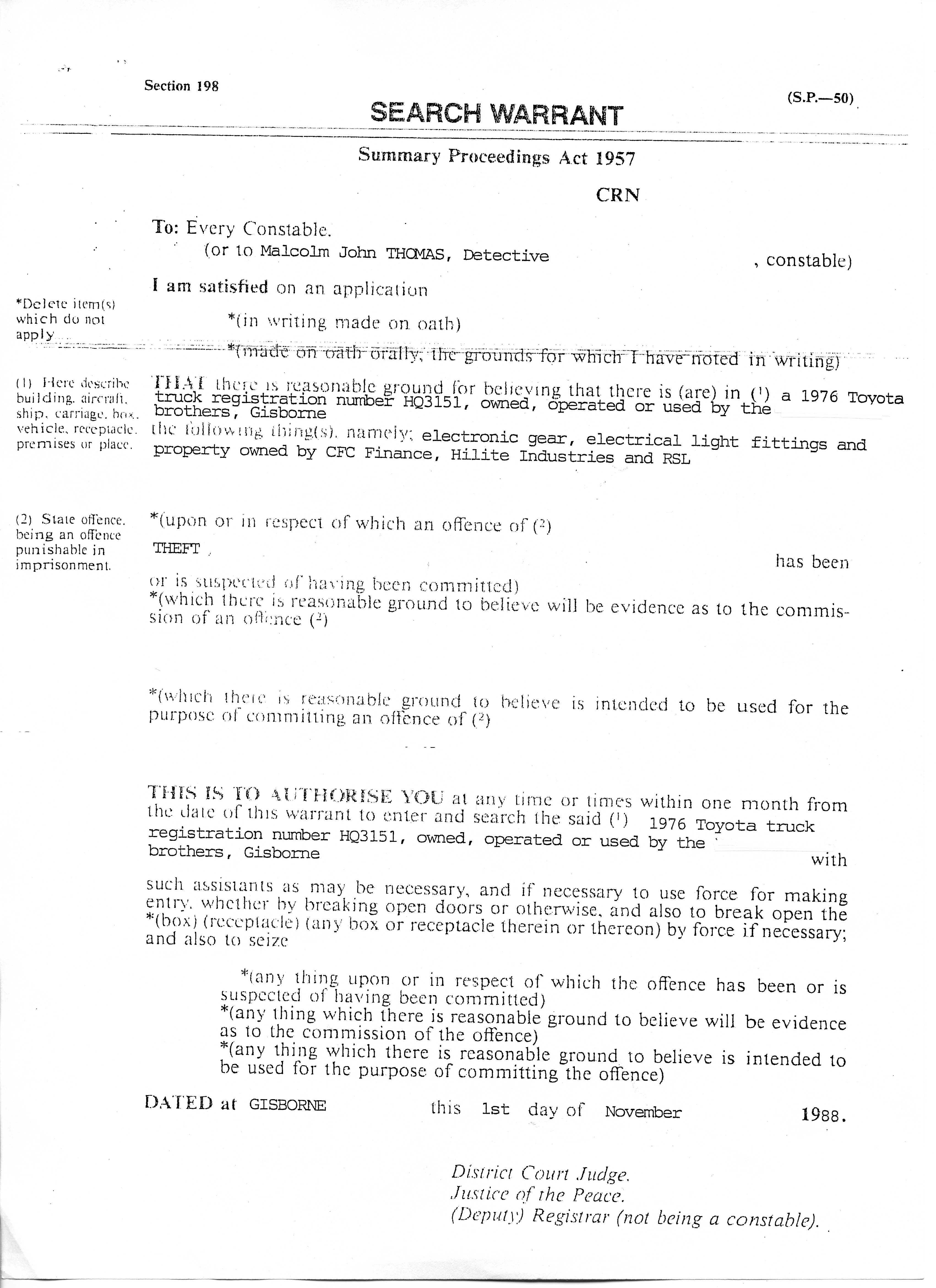
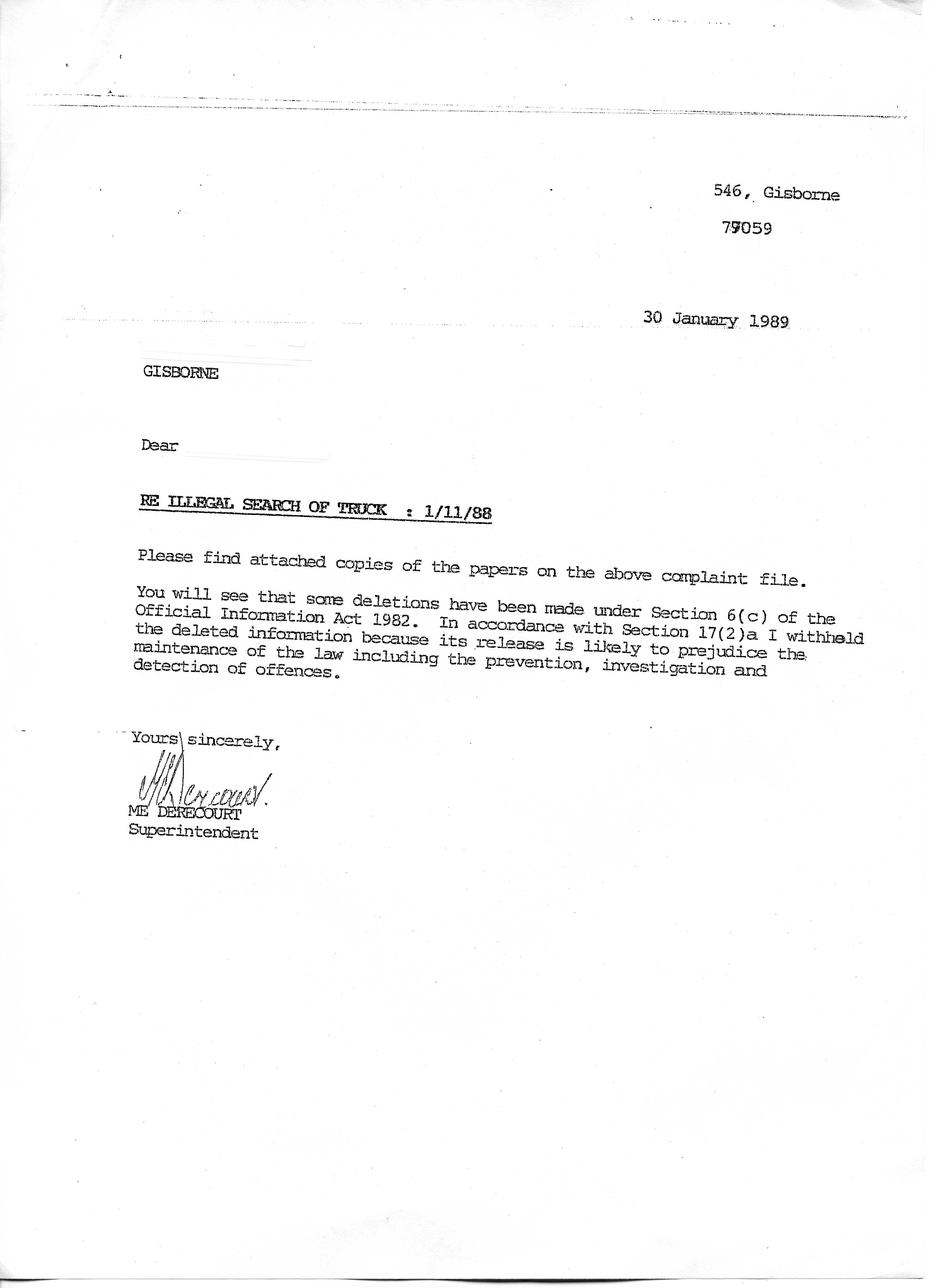
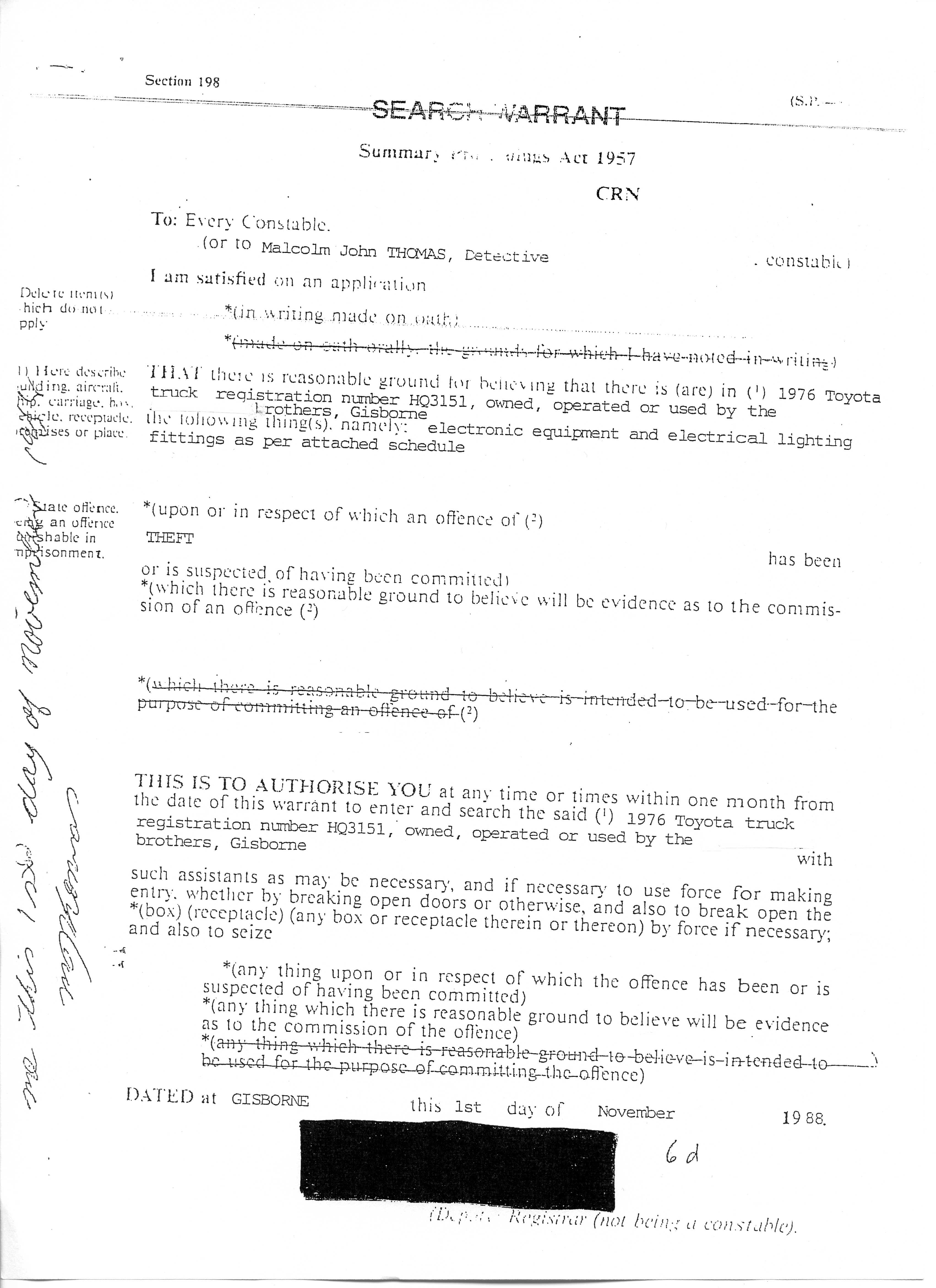
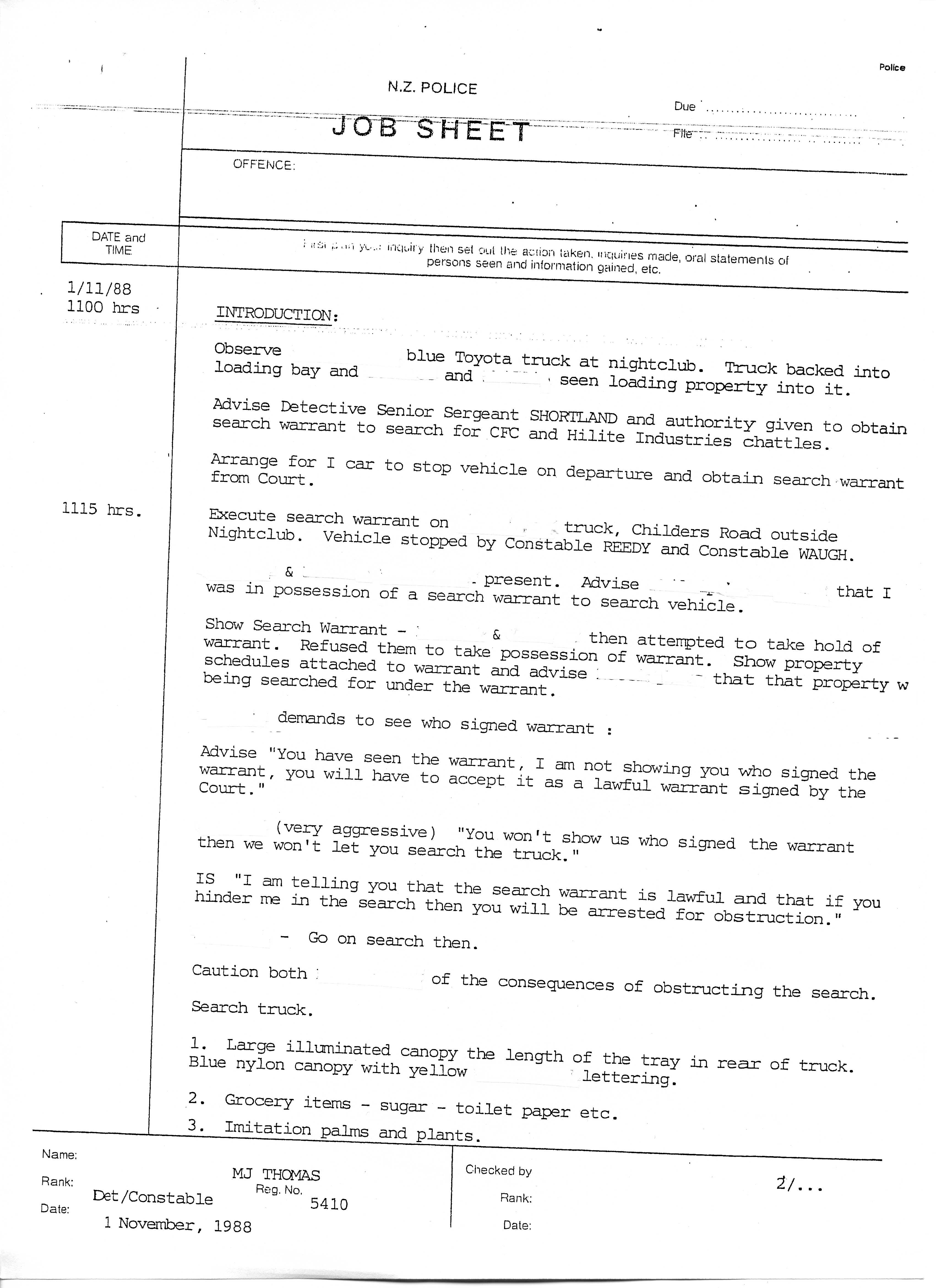
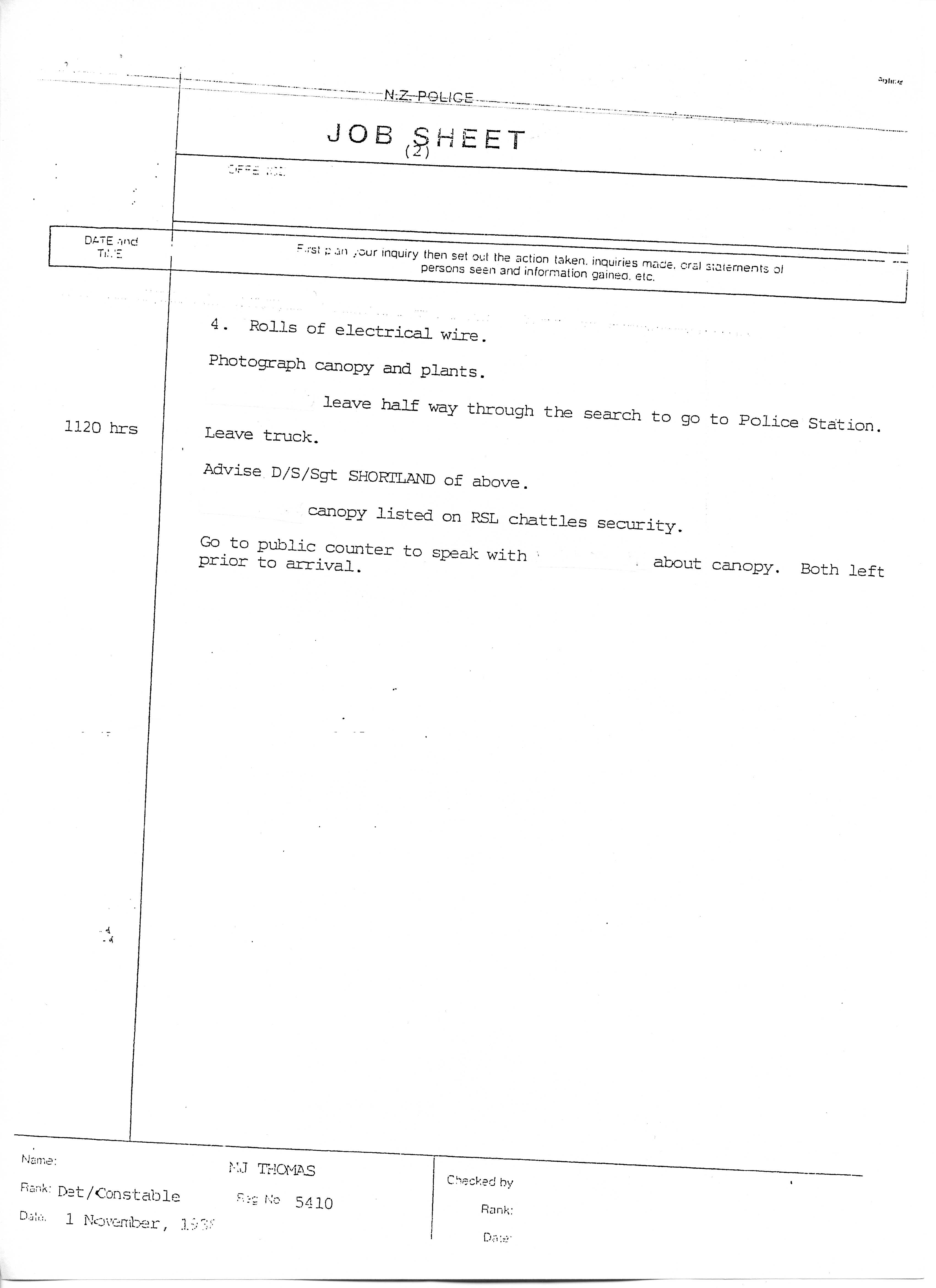
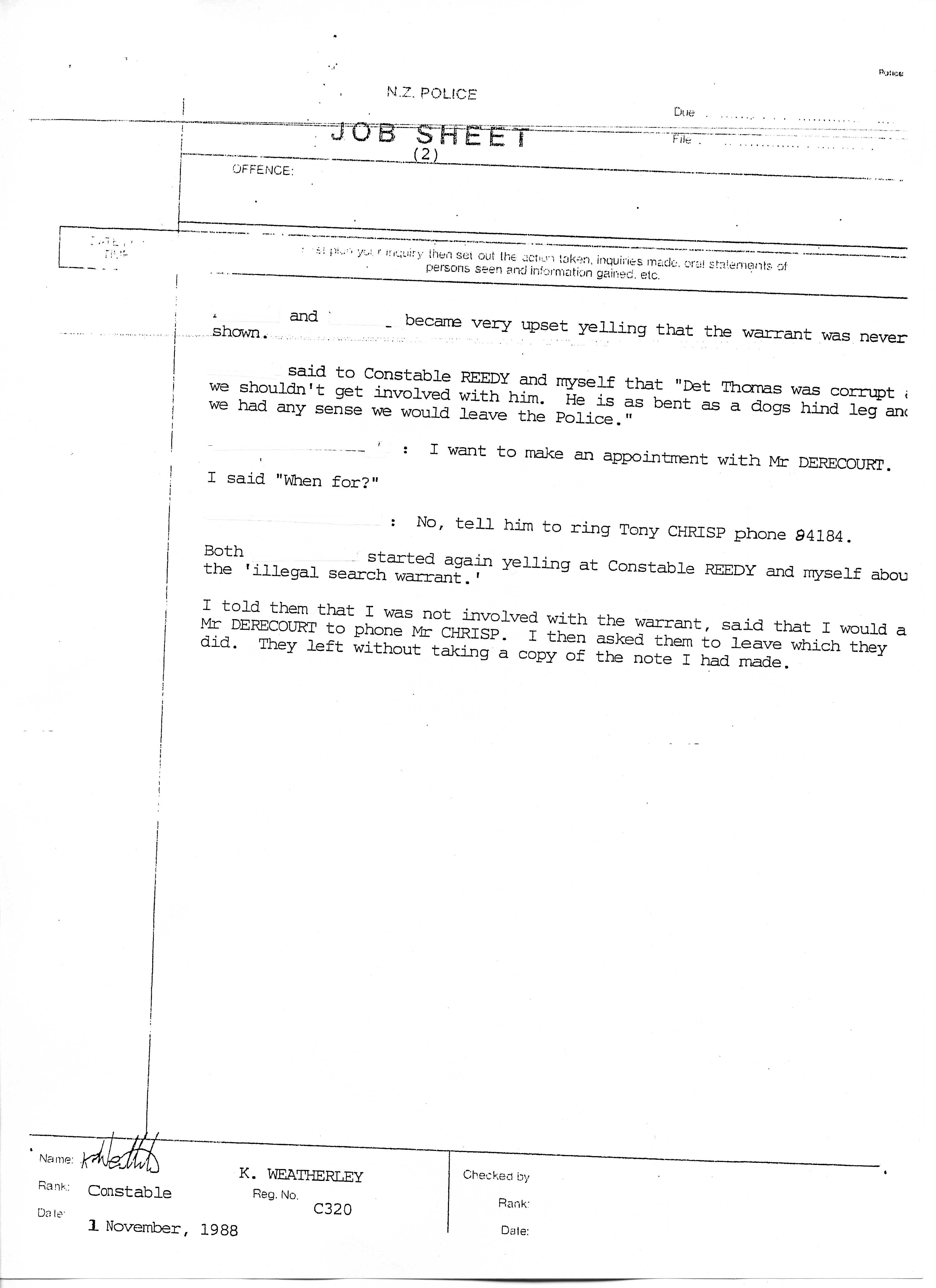
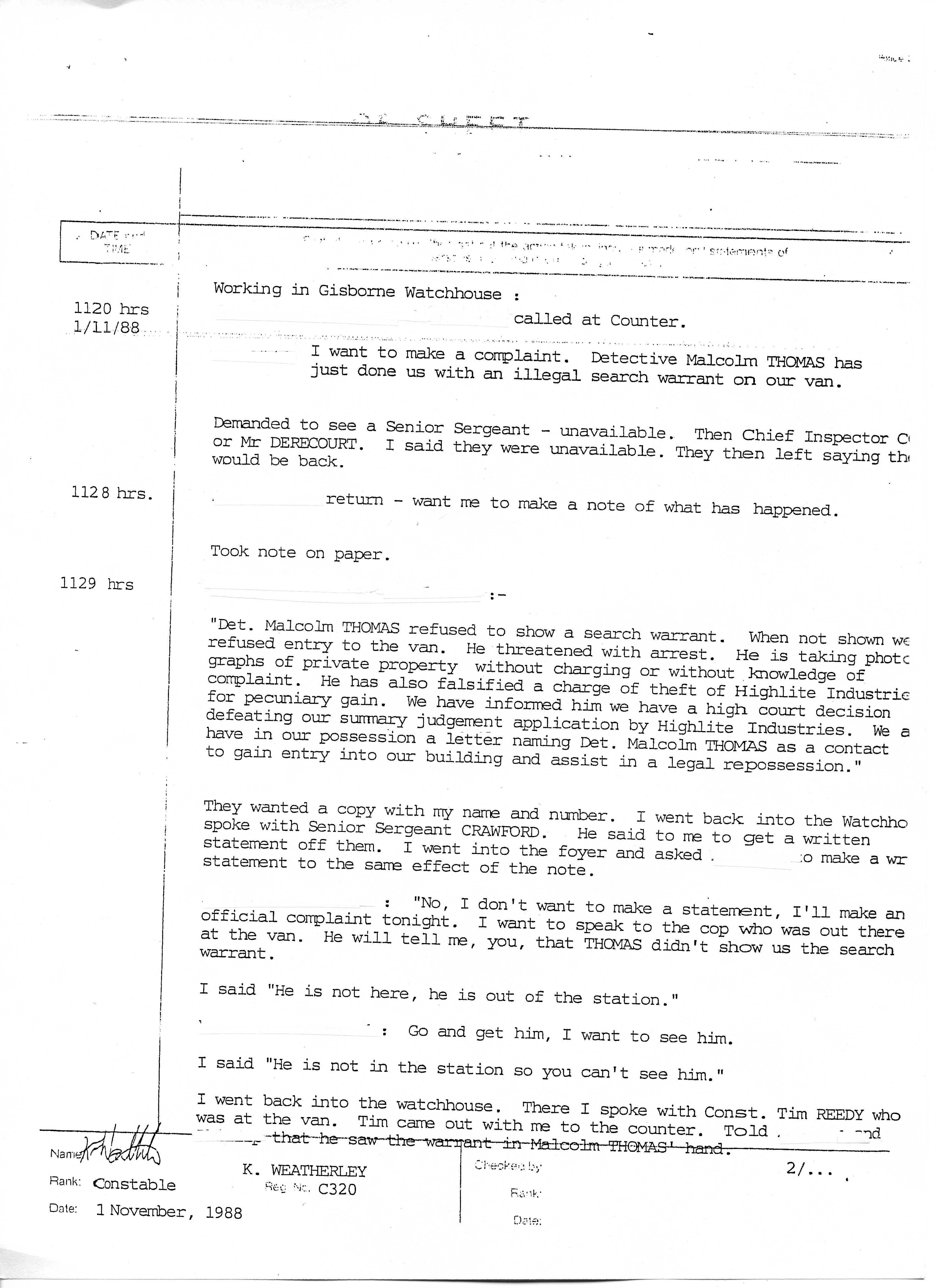
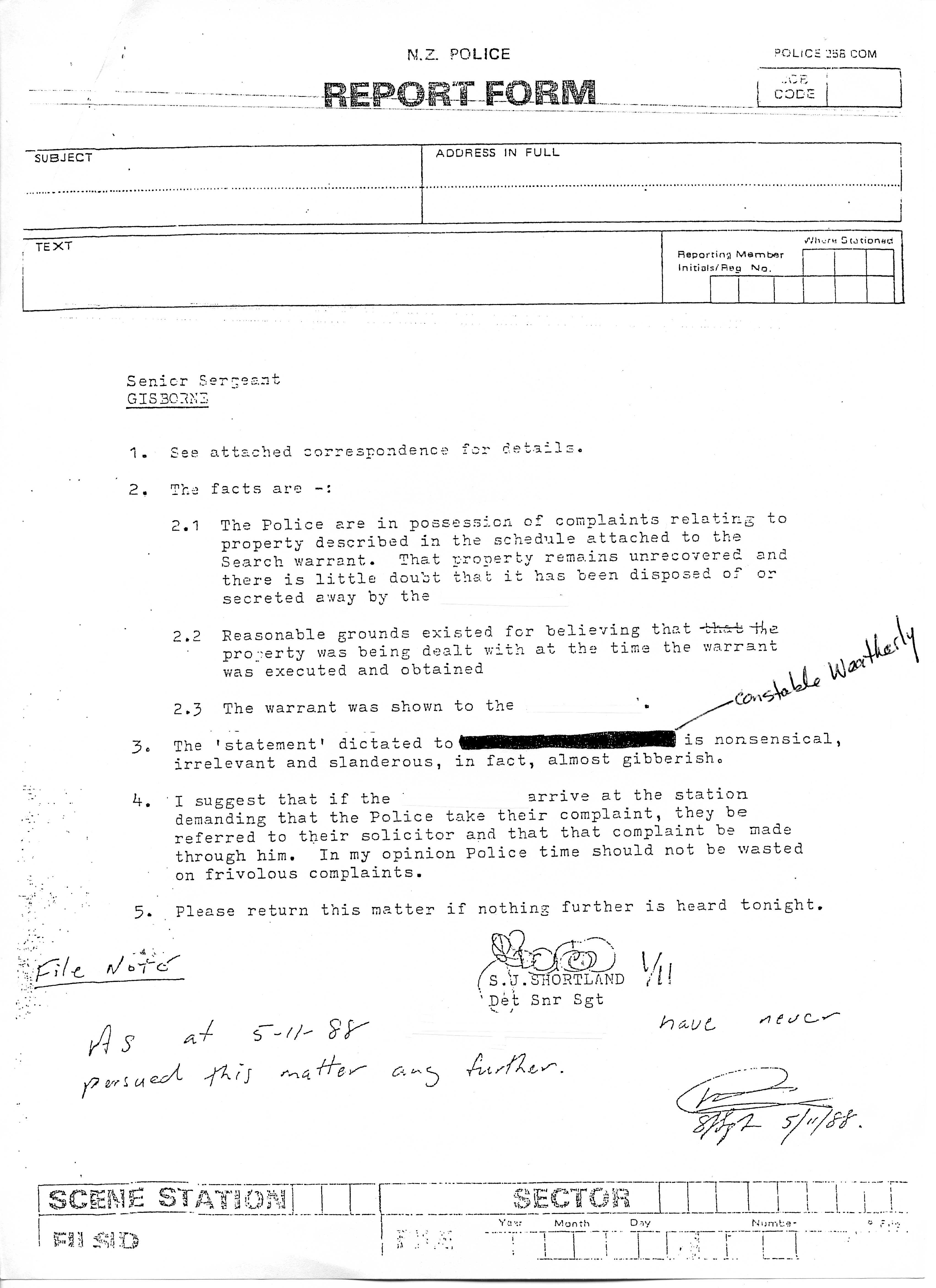
No Comments
Interesting article, one should look at 26632 State v Covert, in the Supreme Court of Carolina, New Zealand it seems are slipping behind the international community in the area of unsigned warrants.